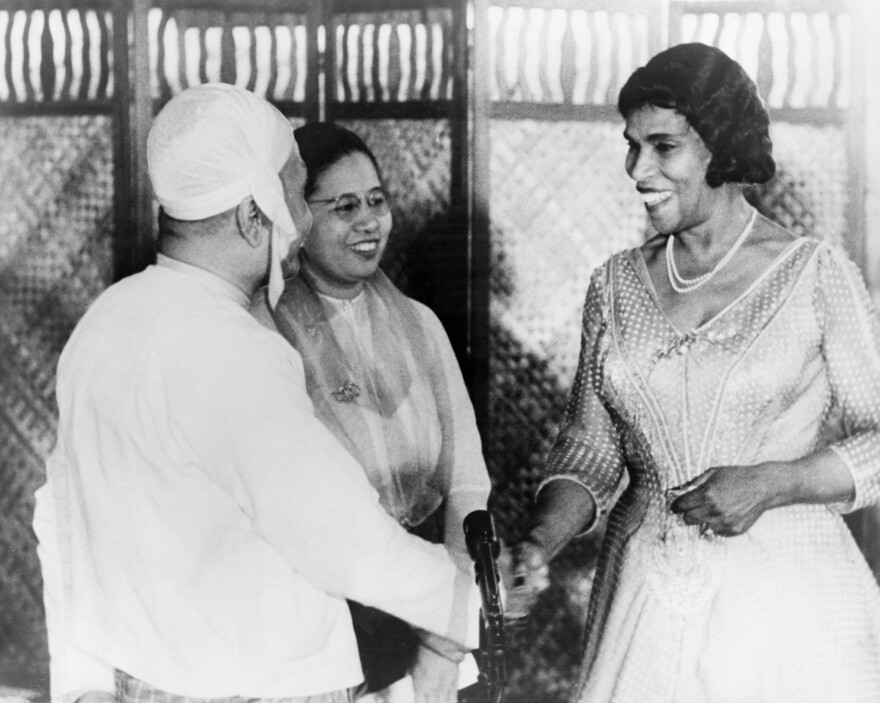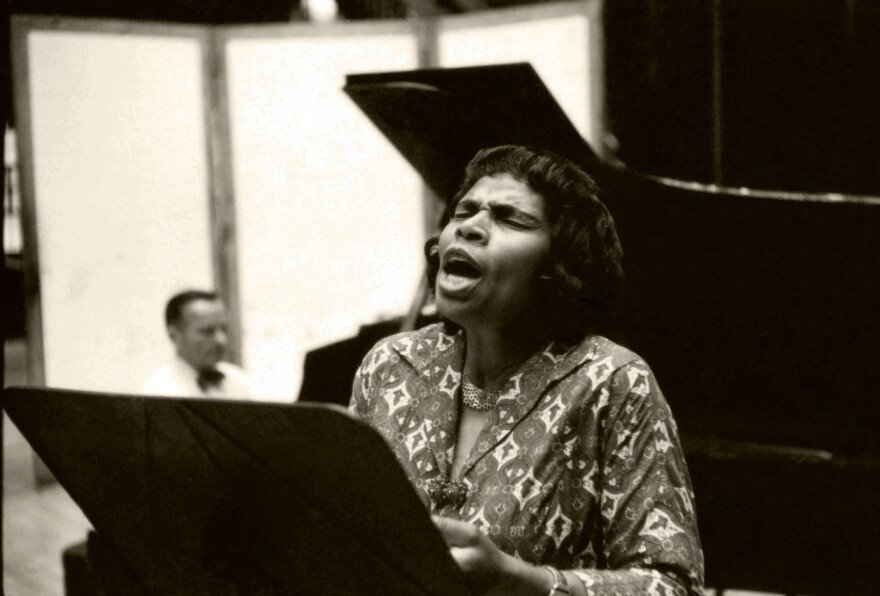Editor's note: Marian Anderson: Beyond the Music, a new deluxe set of albums and images, released Aug. 27, captures the life and work of America's groundbreaking artist. Hear a playlist of selected songs at the end of this story.
Seeing her in the studio gives me strong Aretha vibes. She's not at the piano, as the Queen of Soul often was, but the instrument is at her service nonetheless. It and everything else were there for her: The wood-paneled room and condenser microphone hanging overhead are but two more surfaces for her to command so that she might be lifted from her environment into ours. We welcome her flight but we aren't used to seeing and hearing her in this way.

The great contralto Marian Anderson was a concert singer. She was live, on stage, singing in the foreground of giants cast in white Georgia marble. Rather than coming to us, those iconic performances took us to her. We witnessed the breeze play in her fur coat and lights bounce from her brooch, and listened to the texture of her voice through old songs that, in combination, produced new visions. German lieder, Italian arias, and Negro spirituals were all her domain, yet each was uniquely conceived and labored over. Together they formed and enveloped us as she traveled the world as an unofficial ambassador for a country with ideals that were not, and are not yet, realized.

We don't lose her in these studio recordings—she remains luscious and full of verve–yet neither do we hear all that she was. Her interiority as an artist is differently heard in combination with these images that pulse with their own sounds and storytelling. While snapshots of award ceremonies with dignitaries and glamorous headshots show us a version of the global star, we better understand her in and of a vast, intimate world when we see her in the semi-privacy of the recording studio or with her head thrown back in laughter while rehearsing with Leonard Bernstein or captured in her mother's embrace. A domestic worker, she too lived the privations of her race and gender but, like so many others, created something else of that life. Mrs. Anna Anderson's joy in her daughter's tremendous accomplishments was a song of its own.

Beyond the Music reveals that Anderson wasn't the only one singing. Her chorus was influential and wide as she compelled ancestors and contemporaries, family and strangers from here, there, and everywhere into song. Her praises remain in our throats in celebration and unending thanks for having lived a long life of glorious antagonism and irresistible creation.
Shana L. Redmond is a scholar, author and Professor of English and Comparative Literature and the Center for the Study of Ethnicity and Race at Columbia University.

Deeper Into The Music: A Marian Anderson Playlist
"Deep River" (arr. Harry T. Burleigh)
On Dec. 10, 1923, Marian Anderson, then just 26 years old, stood before the giant metal horn in a recording studio in Camden, N.J., to make her first recording for the Victor Talking Machine Co. She sang "Deep River," no doubt a song well known to her grandparents, all four of whom had lived in slavery. The hallmarks of the great contralto voice are already in place, with its stunning range and freedom between registers. She enunciates each word carefully, lending a patina of regality.

Jean Sibelius: "Säv, säv, susa"
By 1936, when this recording was made, Anderson had become a huge sensation — but not yet in her home country, where she was denied admission to the first vocal school she applied for. She had spent most of the 1930s in Europe, where conductor Arturo Toscanini made his often-quoted proclamation that a voice like Anderson's appears only "once in a hundred years." She was particularly acclaimed in Scandinavia, where she met the great Finnish composer Jean Sibelius and learned some of his songs.
Purcell: Dido and Aeneas, "When I'm Laid in Earth"
Just six weeks before Anderson cut this recording, she had instantly become a cultural icon and a living symbol of civil rights. Denied the stage of Constitution Hall in Washington, D.C. because of her race, Anderson delivered a historic concert on the steps of the Lincoln Memorial on Easter Sunday, 1939, before a crowd of some 75,000. Her mournful treatment of "Dido's Lament," from Purcell's opera, has the soulful quality of a classic Black spiritual.

"My Soul's Been Anchored in the Lord" (arr. Florence Price)
Anderson closed out her historic Lincoln Memorial concert with this song, which she recorded in the summer of 1941. The arrangement is by composer Florence Price, another groundbreaking African-American woman (the first to have a piece played by a major U.S. orchestra, in 1933), who offered many songs to the celebrated singer. Here, Anderson displays her soprano-like top register, radiating joy and capping the song with a brilliant high A.

"Trampin' " (arr. Edward Boatner)
If "My Soul" (above) represents the lustrous top end of Anderson's voice, "Trampin'," from the same 1941 recording session — also sung at the Lincoln Memorial — shows the rich, velvety deep end of her singular contralto. The curious "bottled" timbre she displays in the final verse creates the otherworldly atmosphere of a traveler bound for heaven.
Johannes Brahms: "Gestillte Sehnsucht" (Stilled Longing) Op. 91, No. 1
In 1930, fellowship money financed Anderson's extended stay abroad. She landed in Berlin, where she resumed an intensive study of German art song (lieder) and sang many recitals. Her command of the language and interpretive expression inspired one Austrian critic to write: "Whoever has heard her sing Schubert, Schumann or Brahms once knows that she is on utterly convincing terms with German musical art." Her recording of the first of Brahms' two "viola" songs was made in 1941 in New York and features violist William Primrose.

Franz Schubert: "Der Tod und das Mädchen"
This harrowing performance of "Death and the Maiden," recorded in 1946, offers Anderson's cinematic contrast between the two characters who inhabit the song: the maiden, in a flickering upper register, and death, who tries to befriend her, in a crepuscular subterranean range. You'd be forgiven if you thought two singers were performing, especially when hearing the descent down to a rock solid low D on the final note.
Giuseppe Verdi: Un ballo en maschera, "Re dell'abisso, affrettati"
Anderson didn't perform a lot of opera. Black artists were not welcome on major American opera stages until Jan. 7, 1955, when Anderson, then 57 years old, broke the color barrier at New York's Metropolitan Opera singing the role of the enchantress Ulrica in Verdi's A Masked Ball. Two days later, she recorded her big scene and the aria "Re dell'abisso, affrettati," with Dimitri Mitropoulos conducting the Met Opera Orchestra.

"Hear de Lam's a-Cryin'" (arr. Lawrence Brown)
Twenty-five years after she was turned away at Constitution Hall, Anderson returned to the Washington venue. It was 1964, the Civil Rights Act had been passed in July and on Oct. 24, Anderson took the stage, with her longtime accompanist Franz Rupp, to begin a farewell recital tour. Her program ranged widely, from Handel arias and Schubert songs to more contemporary pieces, and a haunted performance of "Hear de Lam's a-Cryin'." One of Anderson's achievements was to help secure a place in the concert repertoire for spirituals.
Franz Schubert: "An die Musik"
Anderson retired in 1965, but made a final recording the following year for RCA, her longstanding record company. The album included Schubert's song in praise of the power of music. The words (by Franz von Schober) could hardly be more fitting for an artist who gave her life to music, and achieved far more: "Often, has a sigh from your harp, a chord, sweet and holy, from you, opened for me a heaven of better times."
Music annotations by Tom Huizenga
(Thanks to Sony Classical for use of the images.)
Copyright 2023 NPR. To see more, visit https://www.npr.org.






